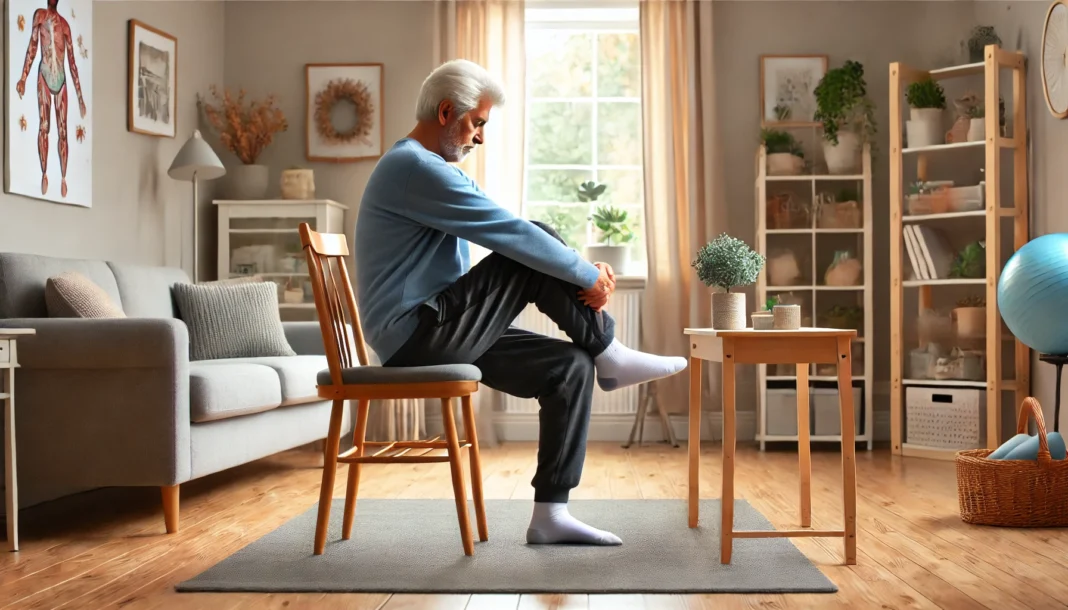Introduction: The Importance of Strengthening the Lower Back in Seniors
As individuals age, maintaining mobility and reducing pain become primary concerns for sustaining an independent and active lifestyle. The lower back plays a critical role in supporting posture, facilitating movement, and preventing discomfort associated with prolonged inactivity. Unfortunately, many seniors experience lower back pain due to muscle weakness, joint degeneration, or a sedentary lifestyle. Engaging in structured lower back strengthening exercises for seniors helps alleviate pain, improve flexibility, and enhance overall stability. By integrating targeted exercises into daily routines, seniors can reclaim mobility, reduce the risk of falls, and enjoy a more fulfilling quality of life.
You may also like: The Ultimate Bodyweight Workout Routine for Full-Body Strength and Performance
Understanding the Causes of Lower Back Pain in Seniors
Lower back pain can stem from various factors, including age-related wear and tear, poor posture, muscle imbalances, or previous injuries. Degenerative conditions such as osteoarthritis and spinal stenosis contribute to stiffness and discomfort, making movement more challenging. Additionally, weakened core muscles fail to provide adequate support to the lumbar spine, exacerbating strain and leading to chronic pain. Without proper intervention, these issues can significantly impact daily activities, from walking and standing to lifting and bending. Incorporating exercises to strengthen the lower back for seniors can mitigate these challenges, promoting better spinal alignment and enhanced physical function.
The Role of Exercise in Lower Back Health and Mobility
Regular physical activity plays a crucial role in maintaining lower back health, especially for seniors. Strengthening exercises target key muscle groups, including the erector spinae, glutes, and core, which collectively support the lower back and improve posture. Gentle movements, such as the seated lower back stretch, help alleviate tension and enhance flexibility. Engaging in a well-rounded regimen of low back pain exercises for the elderly not only reduces discomfort but also fosters greater independence by enhancing balance and coordination. With consistent practice, seniors can develop resilience against injury and prevent further complications associated with an aging spine.
Seated Lower Back Stretch: A Simple Yet Effective Mobility Exercise
Among the most accessible lower back strengthening exercises for seniors is the seated lower back stretch, which offers numerous benefits with minimal physical strain. This stretch helps elongate tight muscles, improving circulation and reducing stiffness in the lumbar region. To perform this exercise, seniors should sit upright in a sturdy chair, gently bend forward from the hips, and reach toward the floor while keeping their back relaxed. Holding this position for 20 to 30 seconds allows the muscles to lengthen and relax, easing tension and promoting spinal mobility. Regular incorporation of this stretch into a daily routine significantly contributes to improved flexibility and reduced lower back discomfort.

Strengthening the Core for Lower Back Support
A strong core is essential for maintaining spinal health, as it provides stability and reduces undue pressure on the lower back. Seniors can benefit from core-focused movements such as seated knee lifts, pelvic tilts, and abdominal contractions. These exercises enhance muscular endurance, allowing the lower back to sustain better posture and movement control. Lower back strengthening exercises for seniors that incorporate core engagement promote spinal alignment and mitigate pain caused by muscular imbalances. With gradual progression, seniors can enhance their core strength without straining their back, making everyday activities easier and more comfortable.
Improving Flexibility Through Low Impact Mobility Exercises
In addition to strength training, flexibility exercises play a key role in reducing lower back pain and improving movement efficiency. Gentle stretching routines, such as the cat-cow stretch or seated spinal twists, enhance range of motion and decrease muscle tension. These movements encourage better posture and prevent stiffness, reducing the likelihood of experiencing sudden aches or spasms. Incorporating exercises to strengthen the lower back for seniors alongside flexibility training ensures a balanced approach to spinal health. Seniors who prioritize mobility exercises experience greater ease in movement and a reduced risk of falls or strain-related injuries.
How Consistency Enhances Long-Term Lower Back Health
To achieve lasting benefits, seniors should integrate lower back strengthening exercises into their routines consistently. Performing exercises at least three to five times a week allows muscles to adapt and grow stronger, leading to improved stability and pain reduction. Gradual progression, including slight increases in repetitions or resistance, ensures continued improvement without overexertion. Combining a mix of strength, flexibility, and mobility exercises prevents monotony and encourages long-term adherence. Seniors who maintain an active lifestyle through structured exercise regimens experience fewer lower back issues and greater overall well-being.

Frequently Asked Questions (FAQ) on Lower Back Strengthening for Seniors
1. What are the long-term benefits of performing low back pain exercises for elderly individuals?
Engaging in low back pain exercises for elderly individuals offers extensive long-term benefits beyond pain relief. These exercises help maintain spinal flexibility, prevent muscle atrophy, and enhance overall mobility. Seniors who consistently practice lower back strengthening exercises experience improved posture, which reduces strain on the lumbar spine and minimizes discomfort. Additionally, strengthening the lower back promotes better balance, decreasing the risk of falls and related injuries. Over time, these exercises can contribute to greater independence in daily activities, ensuring seniors maintain a higher quality of life.
2. How does a seated lower back stretch improve flexibility and circulation?
The seated lower back stretch is a gentle yet highly effective movement that promotes flexibility and blood circulation in the lower spine. By lengthening the muscles in the lumbar region, this stretch helps reduce stiffness and tension that often develop from prolonged sitting or inactivity. Improved circulation ensures that oxygen and essential nutrients reach the spinal tissues, aiding in recovery and reducing inflammation. Regularly incorporating seated stretches into a routine enhances range of motion, making other exercises to strengthen the lower back for seniors more effective. This movement also encourages relaxation, helping to alleviate stress-related muscle tightness in the lower back.
3. What are the best modifications for lower back strengthening exercises for seniors with limited mobility?
For seniors with limited mobility, modifying lower back strengthening exercises ensures safety and effectiveness. Seated versions of traditional standing exercises, such as seated knee lifts or gentle pelvic tilts, allow for controlled engagement of the lower back muscles. Resistance bands can be used instead of bodyweight movements to provide low-impact muscle activation. Water-based exercises, such as aqua therapy, are particularly beneficial as they reduce strain on the joints while allowing for a full range of motion. Additionally, practicing supported movements, such as performing stretches while holding onto a chair, helps maintain stability and prevent falls.
4. Can low back pain exercises for elderly individuals help with conditions like arthritis?
Yes, targeted low back pain exercises for elderly individuals can alleviate symptoms associated with arthritis. Gentle movement improves joint lubrication, reducing stiffness and discomfort caused by osteoarthritis. Strengthening the muscles surrounding the spine provides additional support, minimizing the pressure placed on arthritic joints. Stretching exercises, such as a seated lower back stretch, can enhance flexibility and reduce the likelihood of painful flare-ups. When combined with proper hydration and a well-balanced diet, these exercises help seniors manage arthritis symptoms and maintain an active lifestyle.
5. How do breathing techniques enhance the effectiveness of exercises to strengthen the lower back for seniors?
Proper breathing techniques play a crucial role in maximizing the benefits of exercises to strengthen the lower back for seniors. Controlled breathing enhances oxygen flow to the muscles, promoting endurance and reducing fatigue. Deep diaphragmatic breathing engages the core, providing additional spinal support during movements. Exhaling during exertion, such as when lifting the knees or performing gentle back extensions, helps stabilize the lower back and prevents unnecessary strain. Additionally, mindful breathing fosters relaxation, reducing muscle tension and improving focus during workouts. Incorporating intentional breathing patterns ensures safer and more effective exercise execution.
6. How frequently should seniors perform lower back strengthening exercises to see results?
Consistency is key when performing lower back strengthening exercises for seniors. Ideally, these exercises should be performed at least three to five times per week for noticeable improvements in strength and flexibility. However, the intensity and duration should be adjusted based on individual fitness levels and medical conditions. Seniors should start with shorter sessions and gradually increase the number of repetitions or duration as they build endurance. Incorporating regular movement throughout the day, such as stretching during TV breaks, further enhances mobility and reinforces the benefits of structured exercise routines.
7. Are there any lifestyle adjustments that complement exercises to strengthen the lower back for seniors?
Yes, several lifestyle adjustments can enhance the benefits of exercises to strengthen the lower back for seniors. Maintaining proper posture while sitting and standing helps reduce unnecessary strain on the lower back. Investing in supportive footwear and ergonomic seating ensures spinal alignment and minimizes discomfort. Staying hydrated and consuming an anti-inflammatory diet rich in omega-3 fatty acids, lean proteins, and leafy greens supports muscle recovery. Additionally, engaging in low-impact activities such as walking or swimming complements structured back-strengthening exercises by promoting overall circulation and mobility. Adopting these habits creates a holistic approach to spinal health and pain management.
8. What role does balance training play in reducing lower back pain for seniors?
Balance training is essential for seniors experiencing lower back pain, as it enhances core stability and reduces the risk of falls. Exercises such as seated leg lifts, standing heel-to-toe movements, and controlled weight shifts improve coordination and spinal alignment. A strong core supports the lower back, preventing compensatory movements that can lead to discomfort or injury. Balance training also enhances proprioception—the body’s awareness of movement—which is crucial for maintaining confidence in daily activities. Integrating these exercises alongside lower back strengthening movements ensures a well-rounded approach to pain management and functional fitness.
9. Can using assistive devices improve the effectiveness of lower back exercises?
Yes, assistive devices can significantly enhance the effectiveness of lower back exercises for seniors. Stability balls help engage core muscles while providing support during seated exercises. Resistance bands allow for controlled muscle activation without excessive strain, making them ideal for strength training. Supportive chairs with backrests enable safe execution of a seated lower back stretch, ensuring proper posture and alignment. Additionally, foam rollers and massage tools can be used post-exercise to relieve tension and promote muscle recovery. Utilizing these tools makes exercises more accessible and customizable based on individual needs.
10. How can seniors track progress when performing low back pain exercises?
Tracking progress is essential to staying motivated and ensuring continuous improvement in low back pain exercises for elderly individuals. Keeping a journal to record exercise frequency, duration, and perceived pain levels helps seniors monitor changes over time. Using a mirror or video recording can provide visual feedback on posture and form during movements. Gradually increasing the range of motion in stretches, such as the seated lower back stretch, indicates improved flexibility and mobility. Consulting with a physical therapist or healthcare provider allows for professional assessment and personalized exercise modifications. Recognizing small achievements encourages consistency and long-term commitment to back health.

Conclusion: Empowering Seniors Through Lower Back Strengthening
Maintaining a strong and flexible lower back is essential for promoting mobility and reducing pain in seniors. By engaging in targeted lower back strengthening exercises, seniors can alleviate discomfort, enhance posture, and regain independence in daily activities. Incorporating low back pain exercises for the elderly, such as the seated lower back stretch, alongside core and flexibility movements ensures a holistic approach to spinal health. Through consistency and mindful movement, seniors can enjoy improved quality of life and sustained physical resilience. Taking proactive steps today sets the foundation for continued mobility and comfort in the years to come.
spinal health, senior fitness, core stability, mobility training, joint-friendly workouts, gentle exercise, active aging, pain management, functional movement, injury prevention, rehabilitation exercises, healthy aging, strength and flexibility, seated workouts, improved posture, movement therapy, lumbar support, daily stretching routine, non-impact training, senior wellness.
Further Reading:
12 expert-approved back strengthening exercises for seniors
10 Effective Yet Simple Back Strengthening Exercises for Seniors
Low Back Exercises for Seniors: A Guide to Reducing Pain and Improving Mobility
Important Note: The content provided by HealthXWire is for informational purposes only and should not be construed as medical advice, diagnosis, or treatment. While we strive for accuracy, the information presented on this site may not reflect the most current research or medical guidelines. Always seek the advice of your physician or other qualified health provider with any questions you may have regarding a medical condition. HealthXWire does not endorse, recommend, or guarantee the efficacy of any products, services, or treatments mentioned on this site. Users should not disregard professional medical advice or delay seeking it because of something they have read on HealthXWire. HealthXWire is not liable for any damages, loss, or injury arising from reliance on the information provided herein.



